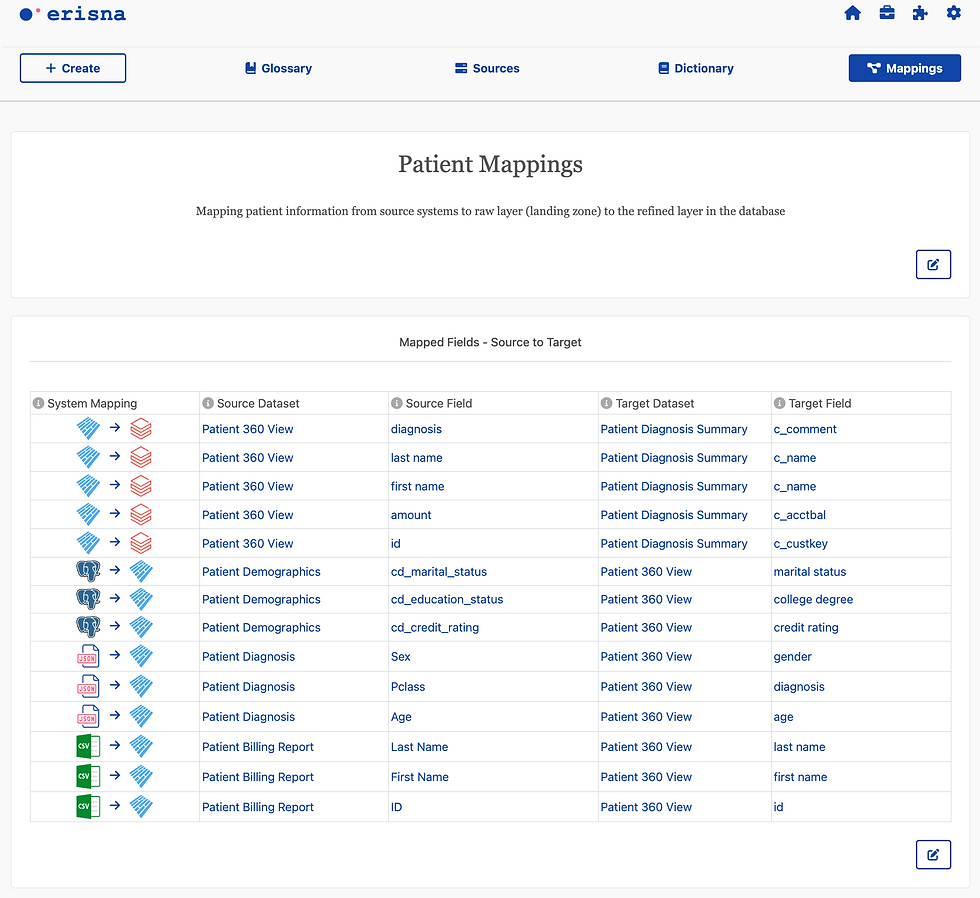
Data mapping is the process of matching fields from one dataset to another. In my last article Designing a Data Mapping Plan, I covered the 3 common ways data mapping is done, and the key components of a data mapping solution.
In this article, I will be more practical and cover the steps needed to implement a data mapping solution.
In the example below, we will focus on a data team using healthcare information at Hospital A to provide management with a simplified view of patient diagnosis. Without further ado, let’s dive in.
1. Identify data entities to include in your data mapping.
Identify the data mapping goals and what you are trying to achieve. Then, figure out the data sources and entities that need to be combined from source to target.
In our Hospital A example, we have identified three source datasets (i.e. 2 files and one database), namely patient_billing_report.csv, patient_diagnosis.json and dbo.patient_demographics in the PostgreSQL database.

2. Determine the fields to include in your data mapping.
Once you have identified your data mapping goals and the data entities required, determine the fields you plan to map from source to target. Put simply, these are where data fields or columns from a source system or format are mapped to corresponding data fields or columns in a target system or format.
In our Hospital A example, these are the source data fields we care about mapping; Patient Billing Report (First Name, ID, Last Name), Patient Diagnosis (Age, Pclass, Sex), and Patient Demographics (cd_credit_rating, cd_education_status, cd_marital_status).
We will be mapping this to a target parquet target format Patient 360 View (amount, first name, id, last name, age, diagnosis, gender, credit rating, college degree, marital status)
3. Define your data mapping business logic or transformation rules.
Data mapping often goes hand-in-hand with data transformation, where data is converted, cleansed, or enriched as it moves from one source to another.
This step will likely require you to write some code that transforms and applies business rules on your data from source to target. Some platforms exist that can also enable you to automate this process. In this case, the software will do much of the transformation work for you.
4. Document your data mapping process.
Although it can feel monotonous and dull to document your data mapping process, this must be done. Small changes such as the naming convention of fields, a tool configuration or updated data can cause big issues. Hence, documenting your data mapping process ensures that everybody is on the same page and data issues are diagnosed quickly.
There are various tools available, ranging from simple tables in solutions like Microsoft Excel to more advanced data mapping solutions like Erisna.

5. Test, deploy and maintain your data mapping solution.
After defining and documenting your data mapping, test your business rules and transformation logic on a smaller dataset to ensure its mapping as expected. Identify and address any data quality issues or anomalies discovered during testing.
Once testing is complete, deploy the data mapping solution to production environments. Ensure proper configuration and integration with existing systems and workflows. Monitor the performance and stability of the mapping process after deployment and establish maintenance procedures to address future changes, updates or enhancements to the mapping logic.
Final Thought
Implementing a robust data mapping solution can foster improved collaboration between internal and external stakeholders, thus enhancing competitive advantage and speeding up the process of gaining insights.
This is a fundamental step in managing and utilizing data effectively. It enables organizations to bridge the gap between disparate data sources, ensuring data consistency, accuracy, and compatibility when integrating, migrating, or transforming data.
By following these steps, organizations can successfully implement a data mapping solution to facilitate the seamless transfer and transformation of data between different systems and platforms.

Erisna is an intuitive, single-view data governance platform that enables organizations to build trust in their data. With tools for Data Discovery, Cataloging, Mapping and Validation that can be understood across the business, Erisna enables data teams to drive efficiency and cost savings when working with data.
